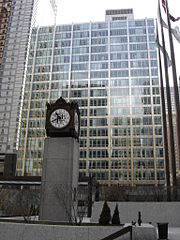 Inland Steel Building in Chicago | |
| Industry | Steel Production |
|---|---|
| Predecessor | Chicago Steel Works |
| Founded | 1893 |
| Founder |
|
| Defunct | 1998 |
| Fate | Acquired by Ispat International |
| Successor | Cleveland-Cliffs (2020–present) ArcelorMittal (2006–2020) Mittal Steel Company (2004–2006) Ispat-Inland (1998–2004) |
| Headquarters | , |
41°40′06″N 87°26′25″W / 41.6684°N 87.4402°W
The Inland Steel Company was an American steel company active from 1893 until 1998. Its history as an independent firm thus spanned much of the 20th century. Originally based in East Chicago, Indiana, it was eventually headquartered in Chicago at the landmark Inland Steel Building.
The company began with the founders' purchase of the land and machinery associated with a failed steel mill in 1893. Inland Steel initially expanded through the efforts of steel industry investors and the family of founder Joseph Block. Inland opened a second steel plant during World War I, and the company continued to grow, making purchases of other companies starting in 1928 to facilitate vertical integration. Demand for consumer products made from steel rose in the 1950s, and the main Inland Steel mill in Indiana Harbor hit its peak employment level in 1969. From then on, the company repeatedly faced reduced demand, economic downturns, and failed business ventures. Over the next few decades, the company shrank and became unprofitable. It was sold to Ispat International, a Dutch firm, in 1998. As of 2020, its assets were owned by Cleveland-Cliffs.
Inland Steel was an integrated steel company that reduced iron ore to steel. It specialized in the basic open hearth steelmaking process. This produced a steel that was resistant to extreme temperature, unlike those made from the Bessemer or acid open hearth processes.[1] Its primary mill, built in 1901, was situated on a large landfill protruding out into Lake Michigan next to the Indiana Harbor and Ship Canal. The steel mill's shoreline location enabled it to take in steelmaking commodities, such as iron ore, coal, and limestone, by lake freighter. Throughout much of its existence, Inland Steel operated its own fleet of bulk carrier vessels.[2]
The company's union, Steel Workers Organizing Committee Local 1010, was established in 1936. Viewed as the most left-leaning of all steelworkers' unions, Local 1010 focused on improving workplace conditions and bargaining for benefits and wage increases for employees. On the occasions that negotiations failed, Local 1010 organized repeated labor strikes.
- ^ Inland Steel Company 1911, p. 11.
- ^ Cite error: The named reference
NISHPwas invoked but never defined (see the help page).
